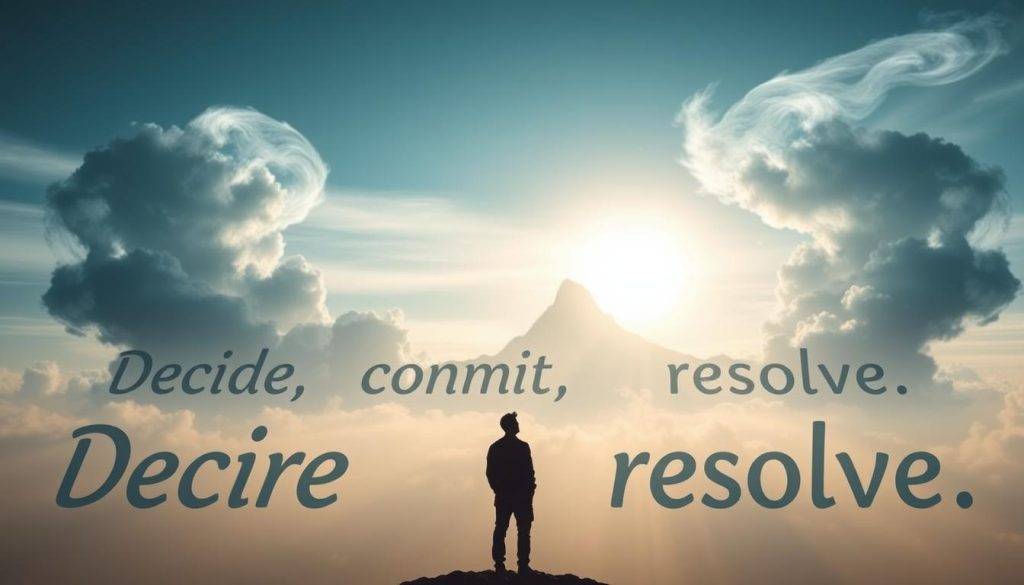“Whatever the mind can conceive and believe, it can achieve.” — Napoleon Hill.
High achievers treat inner work as daily practice. They direct focus and upgrade internal narratives so beliefs match bold outcomes. This is not fluff—it’s a repeatable method that compounds into real life results.
The article shows how the subconscious mind stores beliefs and filters reality, shaping outcomes more than willpower alone. Readers get a practical how-to: frameworks, routines, and tools to train the mind for momentum and measurable success.
Expect clear steps: decide, commit, resolve—turn clarity into action. The guide explains why people hit plateaus and how to update hidden beliefs so new behavior feels normal.
The promise: reframe beliefs, rehearse a new identity, and make aligned action automatic so success becomes a natural extension of who you are.
Key Takeaways
- Top performers treat mental conditioning as daily work that compounds into wealth.
- The subconscious mind holds beliefs that shape real-world limits and possibilities.
- Three-step change—decide, commit, resolve—turns clarity into momentum.
- Focus, rehearsal, and routine make power and success predictable.
- This guide is a practical field manual for aligning beliefs with bold outcomes.
From Stressed and Stuck to Focused and Free: Why This How-To Matters Right Now
Modern work life has turned attention into the scarcest resource—and that scarcity is the real crisis. Daily pressure, nonstop messages, and rising expectations sap clarity and resilience.
The present-day pressure cooker: burnout and workplace stress in the United States
The World Health Organization estimates burnout affects about 28% of professionals globally. In the U.S., the American Institute of Stress reports 80% of workers feel stressed on the job, with workload as the top driver.
Research in the Journal of Occupational Health Psychology links chronic job stress to higher risks of hypertension and heart disease—proof that the cost is physiological, not just emotional.

What high performers do differently with their mind, time, and beliefs
- Frame the stakes: they treat attention like capital and protect it from information overload.
- Budget time and focus: short, scheduled practices interrupt stress loops and restore clarity.
- Curate inputs: elite contributors set boundaries so the subconscious mind encodes useful signals, not anxiety.
- Practice micro-routines: mindful breaks, quick visualization, and targeted affirmations reset state on demand.
Two people with equal skills can diverge when one trains the brain to shift from reactive to responsive. Investing minutes in mental skills yields hours of better decision-making, creativity, and leadership presence. Approach the next sections as a practical toolkit to make that shift sustainable.
Subconscious vs. Conscious Mind: The Hidden Engine That Drives Your Life
Two systems run the human mind: one deliberate and visible, the other quiet and always on.
Define the parts: the conscious mind is present, effortful, and analytical. It handles tasks that need attention, like solving a problem or reading a contract.
The subconscious mind stores beliefs, values, and implicit memories. It filters information and decides what reaches awareness. The unconscious holds experiences you can’t access directly but that still influence feelings.
Example: learning to drive begins as slow, conscious work. With repetition the skill shifts into the subconscious mind, freeing attention for navigation and planning.
Habits are energy-saving scripts the background uses to steer behavior. Fast decision filters—hiring instincts, pitch reactions, negotiation moves—often outrun slow analysis.
Spot autopilot: notice patterns in emails, meeting tone, or procrastination. Those moments reveal where the deeper part of the mind runs the show.
Key point: lasting change comes from updating the code your background runs, not just pushing harder with conscious effort.

Why the Wealthy Train Their Minds: Beliefs, Focus, and Environment
Top earners treat attention like an investment. Small daily focus rituals reduce distraction and steer energy toward clear goals. Over time these rituals compound into reliable momentum.
“Where focus goes, energy flows”: aligning thoughts, goals, and action
Where focus goes, energy flows becomes practical when priorities are scheduled and tracked. Wealthy people lock the few actions that create most success and measure progress with short reviews.

Upgrading beliefs to match big goals—without self-sabotage
Beliefs either accelerate or cap outcomes. Top performers audit inner stories—finding and rewriting narratives that clash with ambition.
“Power grows when thought, goal, and daily habit move in the same direction.”
- Curate your environment: people, media, and business contexts that raise standards.
- Build evidence stacks: small wins that teach the mind what success feels like.
- Run periodic belief reviews and rewrite any line that undermines execution.
| Practice | Outcome | Frequency |
|---|---|---|
| Daily focus ritual | Clear priorities | Daily |
| Evidence stacking | Rising confidence | Weekly |
| Belief audit | Remove self-sabotage | Monthly |
Reassurance: this is learnable. With structured inner work, people in the world of business gain a practical edge—more power, clearer decisions, and steady success.
The Brain Behind Behavior Change: How Reprogramming Works
The brain keeps a running file of past experience that often plays without conscious permission. These implicit memories make reactions feel immediate—old events replay as if they are happening now.
Deeply ingrained responses persist because the nervous system favored them when they first helped. Those defaults stay until new associations are rehearsed enough to overwrite them.
Implicit memory and repetition
Implicit memory runs habits behind the scenes. What the mind repeats becomes encoded and shows up under pressure. Repetition is the practical lever: consistent practice rewires circuits so new behavior becomes automatic.
The state advantage: relaxed learning
When the brain shifts into alpha/theta ranges, it opens to new input. Learning, affirmation, and mental rehearsal are more easily encoded in these calm states.

“Neuroplastic change needs calm attention, clear script, and steady repetition.”
- Do this: rehearse your script when calm, pair a new meaning with old triggers, and repeat daily.
- Stack state (relaxed), script (clear), and repetition (daily) to shift default responses.
- Remember: the mind is a trainable part of performance—steady practice beats bursts of willpower.
| Element | Why it matters | How to apply |
|---|---|---|
| Implicit memory | Drives automatic reactions | Mental rehearsal of new responses |
| Repetition | Encodes new habits | Daily short practices |
| Relaxed state | Improves receptivity | Use breathwork or binaural beats before rehearsal |
| Identity linking | Turns action into who you are | Repeat behaviors that match your desired identity |
Subconscious Programming
Clear mental scripts make action feel automatic. Translate a goal into a short, sensory cue the background mind can follow. This turns vague ambition into a repeatable routine that shows up under pressure.
How to start: set a precise outcome, write an identity statement, rehearse it in a calm state, and cue the environment so the message repeats without force.

- Define the process: reprogramming subconscious mind means giving specific instructions for attention and emotion.
- Use clarity: convert goals into sensory-rich lines the mind can run.
- Daily habit: brief morning and evening run-throughs keep priorities top of mind.
- Pair scripts with calm states to speed learning and lower resistance.
| Step | Action | Frequency |
|---|---|---|
| Set goal | Write one clear outcome with sensory detail | Once |
| Script identity | Short statement in present tense | Daily |
| Rehearse | Calm-state visualization and cue pairing | Morning & evening |
| Reinforce | Environment prompts + accountability | Ongoing |
Result: consistent small inputs reduce friction and make desired choices feel familiar. Over weeks, these practices reprogram subconscious and reprogram mind habits so progress compounds toward big goals.
Decide, Commit, Resolve: A Simple Framework to Reprogram Your Mind
A compact three-step loop—decide, commit, resolve—turns intention into steady results. This framework gives the mind a clear map and a predictable rehearsal to follow when pressure rises.
Decide with clarity: turn vague desires into precise outcomes
Step 1—Decide: write one measurable target. Be specific about numbers, dates, or behaviors so the mind can picture the finish line.
Clarity compresses time by preventing scattered effort and aligning the subconscious mind with a single image of success.
Commit beyond fear: use action to neutralize doubt
Step 2—Commit: take visible action immediately. Movement rewires the nervous system faster than endless planning.
Reframe fear as a cue to break tasks into smaller wins—action quiets doubt and builds evidence of capability.
Resolve with flexibility: assess, adapt, and keep momentum
Step 3—Resolve: review results without ego, change tactics quickly, and protect momentum above method. Resolve means staying outcome-focused while iterating methods.

- Do weekly reviews: what decision sharpened clarity, what commitment stretched comfort, what resolve preserved pace.
- Train the loop: three steps repeated over time teach the mind to expect progress and treat obstacles as data.
- Remember: consistency beats intensity—steady steps accumulate into durable change and real success.
Core Techniques to Reprogram the Subconscious Mind
Targeted mental routines turn wishes into wired responses the brain can follow under stress.
Affirmations that work
Use present tense, specific, and emotional language. An effective affirmation reads like an instruction: “I close the deal calmly, with clear questions.” Keep it vivid and measurable so the mind treats it as executable, not hopeful.
The DICCC method
Apply Marisa Peer’s DICCC: Direct, Instruct, Command, Compel, Code. State short, authoritative lines that overwrite limiting beliefs and give the mind new operating orders.
Visualization rehearsal
Mentally rehearse key moments until the body feels the win. Vivid sensory detail—sight, sound, and feeling—activates neural pathways and prepares performance under pressure.
Gratitude and mindfulness
Gratitude shifts attention from threat to resource, reinforcing optimistic mood chemistry and better choices.
Mindfulness creates space between stimulus and response so conscious behavior can replace old automatic patterns.
- Morning: one mindful breath, a DICCC affirmation, then 60 seconds of visualization.
- Evening: quick gratitude recap to close learning loops.

Measure small shifts in thoughts and micro-habits to confirm these techniques are taking root in the mind.
Biohacks and Tools: Fast-Tracking Lasting Change
Simple biohacks help the mind enter learning states faster, so new habits take hold with less friction.
Binaural beats support relaxed attention by nudging the brain toward alpha ranges. In that calm state, the background mind absorbs new messages with less cognitive strain. Use 10–20 minute sessions before rehearsal to boost retention and focus.

Bedtime theta routines leverage the brain’s theta-rich periods. Before sleep, write one clear intention, visualize the outcome, and repeat a short affirmation as you drift. These minutes encode associations when resistance is low and learning is efficient.
Guided hypnosis is a structured method to surface old patterns and install new narratives. A trained guide or reputable audio course can increase receptivity and replace limiting lines with empowering scripts.
- Efficient use of time: attach these tools to existing rituals—pre-work warmups, evening wind-downs, or short commute sessions—so practice becomes automatic.
- Resources: choose reputable apps and clinicians, and track consistency to measure progress.
- Safety & expectations: these biohacks amplify daytime work; they do not replace deliberate action or coaching.
- Experiment: vary session length and frequency to find the minimal effective dose that fits your schedule.
Bottom line: state management plus precise scripting speeds reprogramming subconscious efforts—combining relaxed state, clear suggestion, and repetition compresses time to results and unlocks more power in daily practice.
Reducing Stress and Elevating Performance at Work
A few deliberate seconds of calm can flip stress into clear performance. These micro-routines prepare the body and mind so decisions land with more clarity during meetings, calls, and deadlines.
Reprogram stress responses before big meetings and deadlines
Pre-meeting script: 60 seconds of slow breathing, a quick success visualization, and an anchor phrase such as “steady and clear.” This three-step cue reduces reactivity and sharpens delivery.
“Preparation of state matters as much as preparation of content.”
Mindful breaks, breathwork, and micro-visualizations during the day
Schedule two-minute micro-breaks every 90 minutes to reset attention and prevent cognitive fatigue. Use a two-breath pause before answering tough questions to stop defensive behavior and buy space for a calm reply.
- Habits checklist: posture reset, slow exhale, concise intention—run before calls, presentations, or negotiations.
- Reprogram subconscious cues: simple visual triggers on your screen or notebook remind you to run the mental script when it matters.
- Track progress: pair objective metrics (meeting quality, task completion) with subjective ratings (composure, presence) at the end of each day.

| Action | Purpose | When |
|---|---|---|
| 60s pre-meeting script | Reduce stress, boost confidence | Before meetings |
| Two-breath protocol | Prevent defensive behavior | Before difficult answers |
| Micro-breaks | Restore focus | Throughout the day |
Why it works: brief, rhythmic routines compound into reliable confidence. Over time, the mind learns to link high-stakes moments with calm execution, so small resets beat marathon efforts for steady performance at work.
Money, Business, and Abundance: Aligning Beliefs with Results
When beliefs about wealth clash, earnings stall; the fix starts with precise language and daily proof. Clear intention + repeated cues let the mind link effort to outcome. That alignment turns scatter into steady results for any business owner with specific goals.
Rewrite conflicting beliefs about wealth and success
Start by naming limiting beliefs that contradict your ambition—examples like “rich people are greedy” or “success changes people.”
Neutralize each line by testing evidence and then replacing it with a balanced truth that honors value and integrity.
Specific money affirmations and abundant visualization habits
- Affirmations: use measurable language: “I’m earning $10,000 monthly doing work I love.”
- Visualization: see invoices paid, confident negotiations, and value delivered—link wealth to service.
- Keep a mood board or a one-minute guided meditation that focuses on exact outcomes.
Designing daily habits that match your financial goals
Try this habit stack example: a 3-minute money vision, one revenue-creating action, and a short gratitude list about cash flow. Track metrics weekly on a simple business dashboard—offers, conversations, conversions, cash.
“Clarity, repetition, and aligned daily behavior turn money intentions into predictable business results.”
Last point: reprogram mind practices must pair with offers made, follow-ups sent, and skills upgraded—evidence builds new beliefs and sustainable success.
Timelines That Stick: How Long Reprogramming Really Takes
Small, steady inputs can yield visible change in weeks; deeper rewrites need patient, repeated work.
Simple shifts often emerge in about 3–4 weeks with daily practice. Habit formation averages around 66 days, though studies show a range from 18 to 254 days depending on task complexity.
Short and long arcs of change: weeks vs. months
Expect quick wins to appear first—energy, focus, and small habits can move fast. Identity-level changes, or beliefs rooted in early experience, typically take months or even years to settle.
What influences speed: depth of beliefs, frequency, and state
The more deeply ingrained a pattern, the more repetitions it needs. Frequency of practice, emotional intensity, and calm brain states act as multipliers and compress the time to results.
“Brief daily reps often beat sporadic long sessions—consistency stacks into lasting change.”
| Factor | Effect on speed | Practical tip |
|---|---|---|
| Frequency | Speeds learning | Daily short rehearsals |
| State (calm) | Improves encoding | Use breathwork before practice |
| Depth of belief | Slows progress | Increase repetitions and evidence stacks |
Advice: score consistency over session length, run cadence reviews every 2–4 weeks, and track milestones so subtle gains stay visible. When practice fits life and leverages prime learning windows, timelines shrink—and true reprogramming subconscious mind efforts become routine.
How to Measure Progress: Signs Your Reprogramming Is Working
Signs of real change appear as clearer priorities, steadier nerves, and smarter risks. These signals show the mind is shifting from scattered effort to deliberate action.
Rising self-awareness shows up first: you notice intrusive thoughts less, recover from strong emotion faster, and choose responses instead of reacting.
Rising awareness, smarter risk-taking, and positive attraction
People who are progressing pick better opportunities. They take measured risks and seem to draw useful information and contacts into their orbit.
“Small shifts in attention create compound changes in behavior and outcomes.”
Behavioral markers: habits, focus, confidence, and follow-through
Track inner signals: fewer intrusive thoughts, quicker emotional recovery, and a calmer baseline under pressure.
- Note confidence gains—speaking up sooner, negotiating fairly, and volunteering for stretch work as markers of success.
- Keep an example log of situations that used to derail you and record how your responses improve over time.
- Capture information on habits: morning priming completed, evening recap done, and weekly reviews held consistently.
- Measure focus by output quality and cycle time; less rework and faster delivery mean cleaner mental scripts.
- Watch alignment: more deliberate yes/no decisions as priorities clear and noise drops.
- Validate progress with peer feedback—others often spot your presence and clarity before you do.
| Indicator | What it shows | How to measure |
|---|---|---|
| Calm baseline | Better stress regulation | Daily self-rating of composure (1–5) |
| Confidence actions | Willingness to lead and negotiate | Count stretch tasks taken per week |
| Follow-through | Improved execution | Task completion rate and cycle time |
| Attraction of opportunities | Positive momentum | Number of relevant inbound leads or useful contacts |
Tie internal cues to external wins—task completion, deal flow, or audience growth—to confirm that the changes in thought and behavior are producing success. Celebrate small signals; acknowledgment speeds consolidation and keeps momentum moving forward.
Avoiding Pitfalls: Environment, Negativity, and Conflicting Beliefs
Inputs around you quietly shape what the mind treats as normal—and that matters more than motivation. Small, repeated signals from media, conversation, and routine write the script your mind runs under pressure.
Curate your information and people
Audit feeds, podcasts, and the people you spend time with. Remove sources that seed anxiety or cynicism.
Seek communities and peers who normalize growth and back the identity you’re building.
Spot belief collisions and resolve them
List goals beside any belief that would block them. When a conflict appears—like wanting wealth but seeing money as corrupt—use a reframe that preserves values while enabling progress.
- Catch: notice the thought that undermines you.
- Question: ask what evidence supports it.
- Convert: write a short, aligned line that keeps your values and enables action.
Reminder: the subconscious favors the familiar. Replace doom-scrolling with a brief practice block and iterate environment design—visual cues, playlists, and supportive people—to protect gains and accelerate change.
Conclusion
Rewriting how you think is less about willpower and more about giving your mind precise, repeatable instructions. When the subconscious mind aligns with clear goals, success becomes the path of least resistance in work and life.
Choose one step today: define one outcome, write three present-tense affirmations, and run a two-minute visualization. Even though fear shows up, small action retrains the brain faster than overthinking and builds confidence.
Use the three-step loop—decide, commit, resolve—review daily, refine scripts weekly, and practice short routines in a calm state. Methods that work: affirmations, visualization, mindfulness, and environmental design.
You have the tools and the plan to reprogram subconscious mind patterns and unlock fuller potential. Start now; progress compounds into lasting change.
FAQ
What is the difference between the conscious mind and the subconscious mind?
The conscious mind is your active thinker—reasoning, planning, and deciding in the moment. The subconscious mind holds learned habits, implicit memories, and automatic reactions that run beneath awareness. Together they shape behavior: conscious choice sets direction, while the subconscious executes patterns that often determine whether you follow through.
How long does it take to reprogram deep-seated beliefs and habits?
Change happens on short and long arcs. Some habits shift in weeks with consistent practice; deeper beliefs may take months of repeated input, state-based learning, and real-world action. Factors that speed progress include frequency of practice, emotional intensity during learning, and the clarity of your goals.
Are affirmations really effective, and how should they be phrased?
Yes—when done correctly. Effective affirmations use the present tense, specific outcomes, and emotional language that feels believable. Pair them with visualization and relaxed states to increase impact. Repeating vague or future-tense lines yields weaker results.
What daily routine helps sustain lasting mental change?
A compact routine blends focused practice and recovery: a morning clarity session (visualization + affirmation), short midday mindfulness or breathwork to reset, and a bedside intention ritual using calm imagery. Consistency and small, measurable actions matter more than duration.
Can guided hypnosis or binaural beats accelerate learning and belief change?
They can. Guided hypnosis and binaural beats help access relaxed brain states—alpha and theta—where implicit learning embeds faster. Use reputable recordings and combine them with clear commands and rehearsal to reinforce new patterns.
Will this work even if I’ve tried and failed before?
Yes—past attempts don’t determine future outcomes. Failures often reveal mismatches between belief systems and goals or lack of state-based practice. Reframe setbacks as data, adjust inputs, and layer technique (visualization, affirmation, behavior) to shift outcomes.
How do high performers use mind training differently?
High performers prioritize mental hygiene: they curate inputs, schedule focused practice, and treat beliefs as assets to upgrade. They use rituals—preparation for meetings, visual rehearsal of outcomes, and recovery practices—to maintain energy and decision clarity.
How can someone spot conflicting beliefs that sabotage progress?
Look for repeated behaviors that contradict stated goals—procrastination, avoidance, or self-sabotage. Ask: what story do I tell about success, money, or worth? Testing new behaviors in low-risk situations reveals collisions between conscious desire and underlying belief.
Is visualization necessary, and what makes it effective?
Visualization is powerful because the brain does not fully distinguish vivid rehearsal from real experience. Effective visualization includes sensory detail, emotional charge, and a clear end-state. Rehearse the process and the outcome to build neural pathways for success.
How should someone measure progress when reprogramming their mind?
Track behavioral markers: improved follow-through, clearer decisions, reduced reactivity, and increased confidence. Quantify wins—completed tasks, revenue growth, or better relationships—and note internal shifts like calmer focus and faster recovery from setbacks.
What role does environment play in lasting change?
Environment shapes input and reinforces habits. Curate people, media, and routines to support goals. Remove triggers that feed old patterns and add cues that prompt chosen behaviors—design your space to make new habits easier and old ones harder.
Can gratitude practices actually rewire outlook and resilience?
Yes. Daily gratitude shifts attention toward abundance and strengthens neural circuits linked to positive interpretation. Over time this reduces stress reactivity and supports optimism, making it easier to take risks and persist toward goals.
What are practical first steps for someone ready to start reprogramming their mind?
Begin with clarity: define one specific outcome and why it matters. Establish a short daily routine—affirmation, 2–5 minute visualization, and one aligned action. Track small wins and adjust based on what yields real behavioral change.
How do you prevent new habits from fading after initial enthusiasm?
Anchor practice to existing routines, use accountability, and design micro-habits that are easy to repeat. Use state-based triggers (morning calm, pre-meeting breathwork) and review outcomes weekly to sustain motivation and iterate until habits stick.




























































